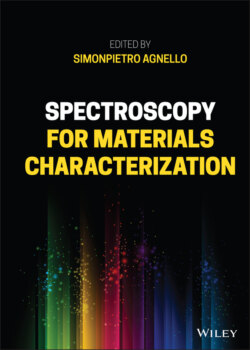Читать книгу Spectroscopy for Materials Characterization - Группа авторов - Страница 72
3.6.3 Ultrafast Relaxation Dynamics of Carbon‐based Nanomaterials
ОглавлениеBesides the investigation of ultrafast relaxations within a given physical system, such as a molecule, solid, or nanomaterial, femtosecond techniques allow to investigate the interactions of materials with the external environment and with external agents, often characterized by very fast photoreactions. As an example, we report an ultrafast study of the interaction of metal ions with carbon nanodots (CDs), a recently discovered family of fluorescent carbon‐based nanoparticles [29]. In particular, the aim of the work was to investigate the changes of the optical properties of CDs induced by metal ions in solution, demonstrating the occurrence of an emission quenching and explaining the underlying mechanism.
The typical photocycle of CDs begins with the instantaneous photogeneration of an electron–hole couple where the electron is exposed to the environment on the surface, while the hole remains inside the core of the nanoparticle [70]. The surface electron first undergoes strong solvent‐induced relaxation on femtosecond and picosecond timescales and, at longer times (in the nanosecond range) the exciton recombines radiatively producing the fluorescence. In the presence of even small amounts (μM) of transition metal ions, CDs and ions form stable complexes wherein the fluorescence is strongly quenched. Under the static quenching regime (i.e. quenching of the emission without a variation of the nanosecond lifetime), TA experiments at different concentrations of copper ions were performed in order to clarify the ultimate mechanism responsible for fluorescence deactivation [29].
The TA signal of pure CDs (Figure 3.9a) is characterized at all delays by three contributions: a negative contribution around the pump wavelength, mostly due to ground state bleaching (GSB) associated with the depopulation of the ground state via photoexcitation; a strong stimulated emission (SE) at 520–550 nm, spectrally matching the ordinary fluorescence signal except for its negative sign; and several positive excited state absorption (ESA) signals due to electronic transitions from the excited state toward higher excited states.
The spectral evolution of the signal entirely occurs in the first few picoseconds. The analysis of the observed dynamics shows that the kinetics are dominated by a progressive Stokes shift with negligible signal decay, as can be seen when comparing the peak position of the SE signal at two different times (Figure 3.9a). This behavior can be attributed to excited state solvation, as well‐known for other systems [3, 4], and a detailed analysis of data in Figure 3.9a shows that the solvation timescales for CDs are 0.19 ps and 2.1 ps. Adding the external agent in solution (i.e. copper ions, Figure 3.9b) does not modify the shape of the signal. However, the entire signal now undergoes a progressive decay (compare the amplitude of the two signals in Figure 3.9b). Notably, a detailed analysis shows that the two timescales of this decay are found identical to those of solvation.
This result is consistent with a model in which fluorescence quenching is caused by an electron transfer from the CD to the ions: the consequent loss of correlation between electron and hole hinders radiative recombination causing the deactivation of the fluorescence, which we see in real time as a progressive decay of the SE signal in Figure 3.9b. Interestingly, the result that this electron transfer occurs bi‐exponentially on the same timescales of aqueous solvation, 0.19 and 2.1 ps, suggests that the photochemical electron transfer reaction is essentially driven by solvation. In this picture, while solvent molecules rearrange around the surface of the photoexcited CD–ion complex, on picosecond and sub‐picosecond timescales, they are responsible for driving the photoexcited system from the initial state to a final one in which the surface electron has been entirely transferred to the interacting metal ion, so destroying the e–h pair and fully quenching the emission.
Figure 3.9 TA spectra of bare CDs (a) and with 100 mM of Cu2+ (b) recorded at 300 fs and 10 ps after the photoexcitation. (c) Normalized kinetics traces at the SE signal with different amounts of copper ions (0, 20 mM, 100 mM).
Source:[29]. Adapted by permission of the Royal Society of Chemistry.
